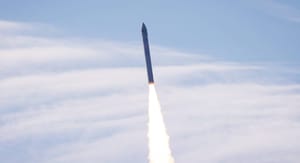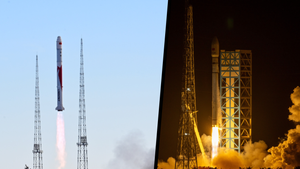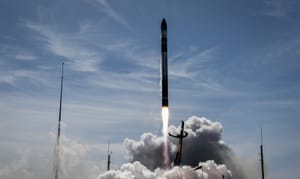
Disclaimer: This article is intended to celebrate the record-breaking flight history of B1058.
Early in the morning of the 26th of December, in Greenwich Mean Time, SpaceX sadly announced that the record-setting booster B1058 had been lost. In an announcement from SpaceX, the reason for the loss was the following:
"During transport back to Port early this morning, the booster tipped over on the droneship due to high winds and waves."
Mitigations to prevent this kind of loss of a booster are allegedly already in place on newer Falcon 9 boosters according to SpaceX.
Booster B1058 has an over three-and-a-half-year flight career making nineteen total flights. At the time of writing B1058 still holds the record for most booster landings in the Falcon 9 fleet.
SpaceX claims B1058 had helped to launch over eight-hundred and sixty satellites to orbit and two astronauts, Douglas Hurley and Robert Behnken for Crew Dragon Demo-2.
What missions did B1058 support?
Flight 1 - 30/5/2020 - Crew Dragon Demo-2
B1058's first flight occurred on the 30th of May 2020 to help carry astronauts Douglas Hurley and Robert Behnken to the International Space Station for the Crew Dragon Demo-2 mission.
During that mission B1058 landed downrange on the drone ship 'Of Course I Still Love You' after launching from Launch Complex 39A. The Crew Dragon Demo-2 mission ended up being a total success.

Flight 2 - 20/7/2020 -ANASIS-II
The second flight of B1058 happened on the 20th of July 2020 to carry South Korea's first military satellite to a geosynchronous transfer orbit. The mission launched from Space Launch Complex 40 and landed downrange on the drone ship 'Just Read The Instruction'.

Flight 3 - 6/10/2020 - Starlink 12
Flight three of B1058 supported the launch of sixty Starlink satellites to low Earth orbit. This mission launched from Launch Complex 39A and landed downrange on the drone ship 'Of Course I Still Love You'.

Flight 4 - 6/12/2020 - CRS-21
B1058's final flight of 2020 occurred on the 6th of December to support the CRS-21 mission to resupply the International Space Station. This was also the first launch of a Cargo Dragon 2 spacecraft.
The launch took place from Launch Complex 39A and landed on the drone ship 'Of Course I Still Love You' downrange.

Flight 5 - 24/1/2021 - Transporter 1
The first flight of 2021 for B1058 happened on the 24th of January. This was the first dedicated Transporter mission from SpaceX and flew to a sun-synchronous orbit carrying dozens of satellites.
This mission launched from Space Launch Complex 40 and landed downrange on the drone ship 'Of Course I Still Love You'.

Flight 6 - 11/3/2021 - Starlink 20
The sixth flight of B1058 supported the launch of sixty Starlink satellites to low Earth orbit. This mission launched from Space Launch Complex 40 and landed on the drone ship 'Just Read The Instructions' downrange.
Liftoff! pic.twitter.com/Dth6zbYtR4
— SpaceX (@SpaceX) March 11, 2021
Liftoff of B1058 for Starlink 20 via SpaceX on X (formerly Twitter).
Flight 7 - 7/4/2021 - Starlink 23
Flight seven of B1058 supported the launch of another sixty Starlink satellites to low Earth orbit. The mission launched from Space Launch Complex 40 and landed downrange on the drone ship 'Of Course I Still Love You'.
Falcon 9’s first stage has landed on the Of Course I Still Love You droneship pic.twitter.com/9a7LUPYZue
— SpaceX (@SpaceX) April 7, 2021
B1058 landing on the drone ship 'Of Course I Still Love You' for Starlink 23 on X (formerly Twitter).
Flight 8 - 15/5/2021 - Starlink 26
The eighth flight of B1058 supported the launch of yet another sixty Starlink satellites to low Earth orbit. The mission lifted off from Launch Complex 39A and landed on the drone ship 'Of Course I Still Love You' downrange.
Liftoff! pic.twitter.com/7kNtDdyouH
— SpaceX (@SpaceX) May 15, 2021
Liftoff of B1058 for Starlink 20 via SpaceX on X (formerly Twitter).
Flight 9 - 13/11/2021 - Starlink Group 4-1
Flight nine of B0158 supported the launch of fifty-three Starlink satellites to low Earth orbit. This mission launched from Space Launch Complex 40 and landed downrange on the drone ship 'Just Read The Instructions'.
This was also B1058's final mission of 2021.

Flight 10 - 13/1/2022 - Transporter 3
B1058's first launch of 2022 flew the third Transporter rideshare mission to a sun-synchronous orbit. This mission was the first time B1058 landed back at the launch site, landing at Landing Zone 1, after launching from Space Launch Complex 40.

Flight 11 - 21/2/2022 - Starlink Group 4-8
This launch of B1058 supported sending forty-six Starlink satellites to low Earth orbit. The launch occurred from Space Launch Complex 40 and had the booster land downrange on the drone ship 'A Shortfall Of Gravitas'.
Liftoff! pic.twitter.com/XIDjbJtDPz
— SpaceX (@SpaceX) February 21, 2022
Liftoff of B1058 from SLC-40 for the Starlink 4-8 mission via SpaceX on X (formerly Twitter).
Flight 12 - 6/5/2022 - Starlink Group 4-17
The twelfth flight of B1058 supported the Starlink Group 4-17 mission to deliver fifty-three Starlink satellites to low Earth orbit. B1058 landed downrange on the drone ship 'A Shortfall Of Gravitas' after launching from Launch Complex 39A.
Falcon 9’s first stage has landed on the A Shortfall of Gravitas droneship pic.twitter.com/Yvw0IDTGa1
— SpaceX (@SpaceX) May 6, 2022
B1058 landing on the drone ship 'A Shortfall Of Gravitas' during the Starlink Group 4-7 mission via SpaceX on X (formerly Twitter).
Flight 13 - 7/7/2022 - Starlink Group 4-21
Flight thirteen of B1058 supported sending fifty-three Starlink satellites to low Earth orbit for the Starlink Group 4-21 mission. This mission launched from Space Launch Complex 40 and landed on the drone ship 'Just Read The Instructions' downrange.
Liftoff! pic.twitter.com/x5Lo6JrDmq
— SpaceX (@SpaceX) July 7, 2022
Liftoff of B1058 from SLC-40 for the Starlink Group 4-21 mission via SpaceX on X (formerly Twitter).
Flight 14 - 11/9/2022 - Starlink Group 4-2 & BlueWalker 3
The fourteenth flight of B1058 supported the Starlink Group 4-2 & BlueWalker 3 launch, which carried thirty-four Starlink satellites and the BlueWalker 3 test satellite. This launch happened from Launch Complex 39A and landed downrange on the drone ship 'A Shortfall Of Gravitas'.

Flight 15 - 17/12/2022 - Starlink Group 4-37
B1058's final flight of 2022 supported the launch of fifty-two Starlink satellites to low Earth orbit. The mission launched from Launch Complex 39A and landed on the drone ship 'Just Read The Instructions' downrange.
Falcon 9’s first stage has landed on the Just Read the Instructions droneship, completing the 15th launch and landing of this booster! pic.twitter.com/0AXCXTSPRb
— SpaceX (@SpaceX) December 17, 2022
B1058 landing on the drone ship 'Just Read The Instructions' for the Starlink Group 4-37 mission via SpaceX on X (formerly Twitter).
Flight 16 - 10/7/2023 - Starlink Group 6-5
B1058's first mission of 2023 occurred on the 10th of July to support the Starlink Group 6-5 mission carrying twenty-two Starlink satellites to low Earth orbit. The launch took place from Space Launch Complex 40 and landed downrange on the drone ship 'Just Read The Instructions'.

Flight 17 - 20/9/2023 - Starlink Group 6-17
Flight 17 of B1058 supported sending twenty-two Starlink satellites to low Earth orbit for the Starlink Group 6-17 mission. The booster landed on the drone ship 'A Shortfall Of Gravitas' downrange after launching from Space Launch Complex 40.

Flight 18 - 4/11/2023 - Starlink Group 6-26
B1058 launched its second-to-last mission on the 4th of November supporting the Starlink Group 6-26 mission to send twenty-three Starlink satellites to low Earth orbit. The booster once again lifted off from Space Launch Complex 40 and landed downrange on the drone ship 'A Shortfall Of Gravitas'.

Flight 19 - 23/12/2023 - Starlink Group 6-32
The final mission for B1058 was the Starlink Group 6-32 mission to deliver more Starlink satellites to low Earth orbit. B1058's final launch took place from Space Launch Complex 40 and landed for the last time on the drone ship 'Just Read The Instructions' downrange.

What is Falcon 9?
Falcon 9 is currently the world's only operational partially reusable medium-lift launch vehicle. The rocket is manufactured and operated by American aerospace company SpaceX. Falcon 9 currently launches from Vandenberg Space Force Base, in California, and Cape Canaveral, in Florida.
SpaceX claims that Falcon 9 can send up to 22,800 kilograms into low Earth orbit when expended or 18,400 kilograms when reused. Similarly, it can send up to 8,300 kilograms into geosynchronous transfer orbit when expended or 5,500 kilograms when reused.
The first-stage is powered by nine Merlin 1D engines burning rocket-grade kerosene and liquid oxygen to generate 771 tons of thrust for up to two-minutes and forty-two seconds of burn time.
The second-stage is powered by a single Merlin 1D vacuum engine burning rocket-grade kerosene and liquid oxygen to generate 95 tons of thrust for up to six minutes and thirty-seven seconds of burn time.
For recovery, Falcon 9 has four grid fins and four landing legs on the first-stage. The first stage either lands vertically on a drone ship or on a landing pad back at its launch site, landing back at the launch site causes a reduction it payload capacity.
On the pad, the rocket is 70 meters tall with the first and second stages 3.7 meters in diameter, the fairing is 5.2 meters in diameter and tapers out from the top of the second-stage. Fully fuelled Falcon 9 weighs approximately 549,000 kilograms.



